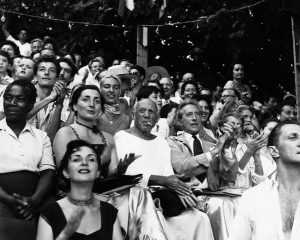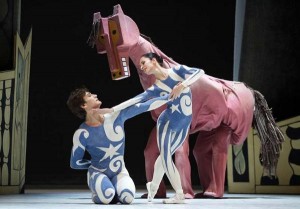Picasso, Mon Ami
Picasso, Mon Ami: Dancing Arm-in-Arm with the Master
During the 1950s in Provence, John Richardson dined often with his neighbor, Pablo Picasso, whom he says liked to startle supper guests with unpopular foods like Spanish marzipan and ancient Chinese eggs. Richardson, biographer and intimate friend of the artist, spoke to a very full house at Benaroya Hall on December 8 in conjunction with both Seattle Arts & Lectures and the traveling Picasso exhibition whose first stop in the U.S. was the Seattle Art Museum. He is in the process of completing the fourth volume of a four-part biography, the first three of which have taken about fifty years to write.
“When the woman changes, everything changes” says Richardson at the very start of the talk, meaning that in addition to the expected “change of dog, change of food, change of house,” the acquisition of new lovers also transformed the way Picasso worked with his paint or bronze or wood. Now well-established, this concept is one of Richardson’s contributions to art history, an observation afforded by not only scholarship and a critical eye but proximity to Picasso’s work, lovers, and dinner table.
At some point Richardson met and befriended Dora Maar, a former lover of Picasso and a talented, well-connected artist in her own right. “When the woman changes, the poet changes,” she told Richardson one day, a slight rewording of the same observation. Whether Maar meant this primarily as a figure of speech, several poet-friends did in fact come in and out of Picasso’s life: Gertrude Stein, Max Jacob (with whom the young painter shared an atelier in Montemartre during his early years in France), Andre Salmon, Paul Eluard, Guillame Apollinaire, and Jean Cocteau were all close friends of his at some time or another. Richardson can recall how it felt to be one of Picasso’s intimates, and offers for contrast the example of painter Henri Matisse, around whom “you were very conscious that you were in the presence of a very great man, a very wise man who talked almost in periods.” With Picasso, on the other hand, one felt “completely at ease. He put you at ease, especially the men…He could discuss everything, he was very relaxed, no arrogance or pretension, and he did have this extraordinary sweetness, which he is not always given credit for and generosity, and very very very funny.”

His friendship with the poet-filmmaker Jean Cocteau began after Max Jacob introduced them in 1916 and lasted fifty years. Awestruck by the then thirty-something-year-old of cubist fame, Cocteau immediately invited him to travel to Rome and collaborate on a project. Picasso, who had just been rejected by the second woman he had proposed marriage to, took him up on the offer to jet out of town and in January of 1917 they met up with notorious ballet master Diaghilev to begin work on a production for his Ballet Russe de Monte Carlo.
Dubbed “A Realist Ballet in One Scene,” Parade was Cocteau’s brainchild and his attempt to create a cubist work for the stage. It has been called the first completely “modern” ballet because it did not use stories, folk tales, or characters from the past as most ballets did. The plot (or lack thereof) is simple: a troupe of circus performers tries to entice passersby on a Paris boulevard to enter their circus tent and watch the whole show. Characters include, among others, a male and female acrobat, a chaval-jupon (hobby horse) danced by one man in front and one at the rear, a “conjurer” who does tricks with an egg and eats fire, and a little American girl who imitates Charlie Chaplin and eludes to the growing popularity of silent film.
Cocteau asked Picasso to design the theater curtain, set, and costumes. On the curtain he rendered a fairly representational but typical Picassian circus scene, while the set and costuming were heavily cubist and geometric, less representational. Many of the costumes stood ten feet tall and were constructed out of nontraditional materials (wood, metal, papier mache, cloth, and metal) and awkward for the poor dancers to motor around in. Besides the awkwardness, the master-artist also ran up against a few amusing costume glitches characteristic of the trials and tribulations of the theater. During dress rehearsal a mannequin jockey riding on top of the hobby horse toppled off, the audience burst out laughing, and the silly little rider was tossed off for good, never making it to the final staging. Also, the female acrobat costume required last minute revisions such that Picasso had to paint spiral designs by hand onto the gymnastic ballerina-legs of Lydia Lopoukhova.

Léonide Massine, Diaghilev’s lover at the time, served as choreographer of Parade, as well as one of the dancers in the piece. Cocteau then recruited Eric Satie to write the score, which incorporated a very American Ragtime song, as well as sirens and other jarring sound effects—the acrobats danced to a xylophone and the clink-clank of milk bottles, the little American girl was attended by typewriter noises, while lottery wheels and water noises accompanied the conjuror dance (in the end, Diaghilev tried to remove these sounds altogether). As a final touch, the poet Guillame Apollinaire composed the program notes for opening night. That document is historically significant because in it he coined the word “surrealism” three years before the movement officially took off.
From a safe distance, we can recognize the extent to which the project embodied a true convergence of modernists across several genres and pointed to Paris as the crescent of this fertility, but when Parade premiered at Paris’ Théâtre du Châtelet in May of 1917, it was received by both cheerers and jeerers—and the jeerers were louder. After the performance, which clocked in at just fifteen minutes, the audience threw oranges at the orchestra. Eric Satie was bitch-slapped. In print, the critics were not friendly, either.
Over the next few years Picasso participated in several of Diaghilev’s ballets, though he basically told the ballet master to go screw himself when in 1923, hoping to restage it, Diaghilev asked Picasso to touch-up Parade’s mildewed curtains. The deterioration, insisted Picasso, was no different than that of Pompeii’s disappearing frescoes.
Though others found him terribly temperamental, Picasso also remained in good contact with Parade’s mastermind. From the very beginning of their acquaintance Cocteau had proudly situated Picasso “at the heart of [his] creative pantheon,” whereas Picasso is reported to have said, “Cocteau is the tail of my comet.” The nature of their uneven dynamic may in part account for the half-century staying power of the relationship. In an interview, Richardson maintains that Picasso was a “cannibal. He needed people who understood his work, loved his work, respected him, desperately, because that’s where he’d get his energy from. After a day with Picasso, where there wouldn’t be any stress of any kind, you suffered from total nervous exhaustion…whoever you were, if he had taken a shine to you or he sensed that you were susceptible to this treatment then he was like Dracula. He drained your last drop. Which of course was very gratifying, you felt that you’d contributed something.” Cocteau, who after working on Parade with Picasso wrote a half-dozen letters home to his mother raving about his new friend’s genius, no doubt experienced this phenomenon—exhilaration, and then exhaustion.
John Richardson stresses that if you want to understand Picasso, you must see him as a host of paradoxes, recognizing that he was both selfish and generous. A misogynist who totally adored women. “He was so unlike what you expect a great genius to be. He was a friend and a lot of time we were on the bed together or having lunch in a bistro… easy-going and warm and physical. He gave you hugs, regardless of whether you were male or female, young or old; he would always stroke you.”
Once, early in their relationship, when Cocteau was sick in bed, Picasso sent him a puppy constructed out of cardboard, so masterfully engineered that it could stand up on all fours and wag its paper tail.
